Circuits/Systems
Established in the year of 1977 and 1983 of master and doctorate programs, respectively, the graduate school at the Department of Electrical Engineering has been one of the most prestigious postgraduate institutes in Taiwan. Our department strives to provide graduate studies with research-oriented inter-disciplinary excellence. Currently, there are two research groups of the master and doctorate programs in the department : Power Engineering Group and Circuits/Systems Group.
【 Circuits/Systems Group 】
Faculty : 21 Full-Time Teachers
Postgraduate students :
More than 130 postgraduate students are being recruited in the research group each year.
The main research areas and topics of this group include :
► Speech and Audio Signal Processing
► Multimedia Signal Processing
► Biomedical Imaging and Signal Processing
► System Biology and Bioinformatics
► Human-Centered Behavioral Signal Processing
► RF and Microwave IC
► Advanced Analog & Mixed-Signal IC
► Communication IC
► Biomimetic System IC
► Advanced IC Testing
► Biological Synthetic Genetic Circuit
List of labs in the group :
Automatic Control 、 Signal Processing 、 and Systems Biology Lab
Prof. Bor-Sen Chen
The Control, Signal and Systems biology Lab
Since most systems in the world are nonlinear and stochastic, the Control, Signal and Systems biology Lab focuses on the nonlinear stochastic and partial differential H ∞ robust control design theory and its application to control, signal process and systems biology. Nonlinear stochastic H ∞ robust control is one of the most difficult problem in the control theory and design because the designer needs to consider the nonlinearity, stochastic disturbance, external noise and robustness of the system all together. The Control, Signal and Systems biology Lab is constituted by three research groups: Control theory group, Signal process group and Systems biology group. For the control theory group, we focus on the robust H ∞ control design in the nonlinear partial differential systems and multiobjective H ∞ robust control design in the nonlinear stochastic systems. For the signal process group, we focus on the multiobjective H ∞ robust filter design in the nonlinear stochastic and partial differential systems. In many situations, the designer expects that the controller and filter are not only optimal but also robust so that our lab members are enthusiastic about the application of multiobjective H ∞ robust controller and filter design and have brilliant results. For the Systems biology group, the advent of the era of big data has created many new industries and also promoted scientific research toward an unprecedented direction. In the course of such a large, diverse, and heterogeneous information to be quickly generated, we have noted that the core is the big mechanism hidden behind big data. Through understanding big mechanisms (mathematical models), we can bring the big data more effective application to all levels. Our laboratory has focused on big data in a high-throughput microarray technology and the next generation sequencing to establish a dynamic mathematical model for big mechanisms of the organism in a variety of environmental conditions, such as aging, cancer, immunity, reproduction, diseases, etc. the hot topics in biology. Dynamic mathematical models for big mechanisms of biological systems based on the system identification and big data mining technology can not only explain the underlying mechanisms of biological phenomena but also quantify and measure the various features and mechanisms of biological systems based on the stochastic systems theory, such as stability at all levels of biological networks, sensitivity, robustness, noise filtering capabilities, signal transmission capacity and so on. In the line with engineering robust design, we can design for abnormal and vulnerable parts of biological systems and enhance their robustness.
Communication Science Research Laboratory (CSRL)
Prof. Chung-Chin Lu
The Communication Science Research Laboratory conducts research in four areas:
(1) Error-correcting codes: we focus on algebraic-geometry codes, low-density parity-check codes, space-time codes and polar codes, including code construction and encoding/decoding.
(2) Digital communication system design: we focus on synchronization architecture for OFDM, collaborative coding to mitigate multiple access interference and network coding.
(3) Systems bioinformatics: we focus on gene structure prediction, gene regulation signal prediction, enzyme active site prediction and protein-protein interaction.
(4) Quantum communications: we focus on quantum error-correcting codes, quantum cryptography, quantum detection theory and quantum Information theory. .
IC Design Exploration Lab. (IC-DeX)
Prof. Shi-Yu Huang
The research interests of this lab broadly cover VLSI design, automation, and testing, with prior experiences on formal verification, power estimation, fault diagnosis, and resilient nanometer SRAM Design. More recently, it is more concentrated on all-digital timing circuit designs, such as all-digital phase-locked loop (PLL), all-digital delay-locked loop (DLL), time-to-digital converter (TDC), and their applications to parametric fault testing for interconnects. Also, in response to rising demand of higher reliability for multi-die 3D-ICs used in applications ranging from implantable biomedical electronics, automotive electronics, and hard-to-deploy sensors in Internet of Things (IoT), a nick-named “regenerative long-life design methodology” is currently under exploration. From this lab, two research achievements including “eClock – a cell-based PLL compiler” and “PowerMixer – a multi-level power estimation software tool” were ever made commercial products.
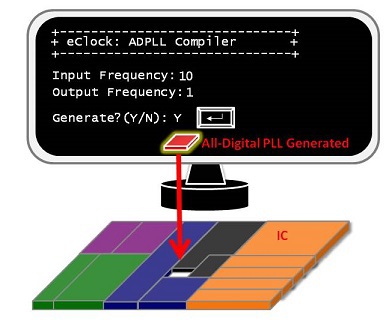
Electronic Circuit and Technology Laboratory
Prof. Mi-Chang Chang
Electronics industry has brought huge changes to our daily lives and will continue to do so in the future. This industry today is primarily built upon semiconductor technologies. With smaller and advanced semiconductor devices and interconnect technology, high performance, low power, low cost and better functionality Integrated Circuits (ICs) are made possible. But, the challenges for the advanced semiconductor technologies are also increasing in difficulty.
One of the important trends of this industry is the increasing mutual dependency of semiconductor technology development and circuit design. Technology limitations can be overcome by placing some constraints to circuit and layout design; on the other hand, circuit designs need to be aware physical implications such as proximity effects. Only co-optimizing both technology and circuit design together, better IC products can be achieved with short time-to-market constraints.
In our lab, we study the impacts of the advanced technologies to integrated circuit performance. Circuit solutions to improved performance, power and area are some of the research objectives. For example, parasitic resistance, capacitance, and even inductance, are no longer secondary effects in circuits designed using advanced technologies. With smaller device and interconnect dimensions, local electric field can be large enough to cause reliability problems. Design methodology to address these effects should be carefully studied; while device design to minimize these effects should also be included or proper models developed to facilitate design simulations.
Design techniques to address these effects are also the focuses of our lab. For example, asynchronous design methodology needs no global clocks and hence no clock skew problem, in addition to the higher performance due to average delay instead of worst-case delay dominates the circuit performance. Due to larger device variations and path skews associated with the advanced technologies, asynchronous design methodology may be an alternative design approach to alleviate constraints from the technology.
Of course, applications of these design techniques are also part of our lab's objectives. An example is the retinal chip design as part of the Sub-retinal Prosthesis Project.
Prof. Jay Cheng
Current research interests–
game theory 、 network science 、 optical queueing theory
Past research interests–
high-speed switching、information theory 、 wireless communications
Laboratory for Reliable Computing (LaRC)- Mixed-Signal Research (MSR) Group
Prof. Po-Chiun Huang
Research Interests : Analog/Mixed Signal/RF Techniques for Wireline/Wireless Communications , SoC Power Managements , and Biomedical Low-Voltage Low-Power Applications 。
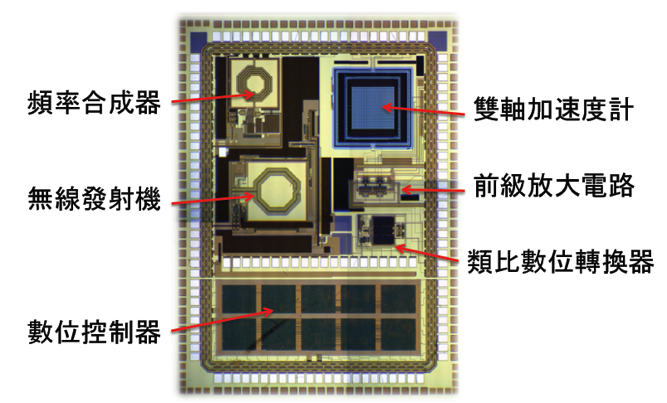
2014 設計 : Integrated MEMs/Mixed Signal/RF/Digital SoC
Prof. Chia-Wen Lin
https://www.ee.nthu.edu.tw/cwlin/
Laboratory for Reliable Computing (LaRC)
Prof. Jing-Jia Liou
Observing the trends of system-level design, our research activities have been focusing on two major themes: (1) the electronic system-level design platform for many cores, and (2) test and diagnosis with machine learning techniques. The following is a detailed description:
1. ESL platform for many-core systems
We have been developing an ESL design platform for many cores which includes processing elements (clusters of CPU cores with local memories), network-on-chip (NoC), and multi-channel external memories. Several parallel benchmark programs have been ported to the platform: object tracking, jpeg encoding, 3D pipeline rasterization, etc. The platform provides a flexible design environments for fast prototyping. We are currently extending the platform for optimization on heterogeneous workloads and non-volatile memory architectures.
2. Test and diagnosis with machine learning techniques
The objective is to develop methods and flows for efficient test and diagnosis on systematic process variations and to use the results to further tune on-chip hardware parameters to increase product yield. Currently we are working on analyzing big test data for system-level tests.
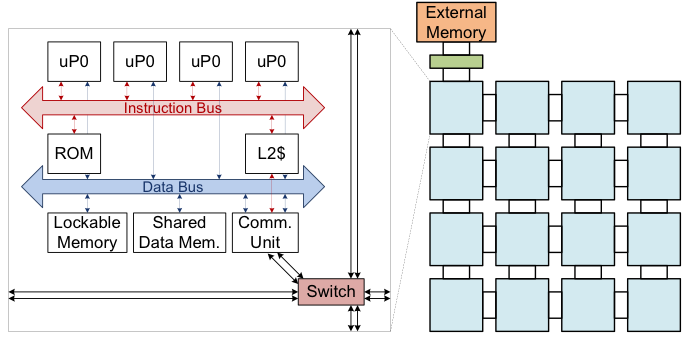
Laboratory for Reliable Computing (LaRC)- Memory Design Lab
Prof. Meng-Fan Chang
l Circuit designs for volatile and nonvolatile memory (SRAM, DRAM, ROM, NOR-Flash, NAND-Flash)
l Ultra-low-voltage and sub-threshold circuit designs (for bio-medical, wearable and IoT applications)
l Circuit designs for 3D-IC and emerging Memory (TSV-RAM, 3D-NAND, ReRAM, PCRAM, STT-MRAM)
l System-circuit co-designs for memory architecture (for cloud and big-data applications)
l Device-circuit co-designs for emerging devices (3D-Monolithic, Spintronics, Memristors, .. etc.)
Laboratory for Reliable Computing (LaRC)
Prof. Hsi-Pin Ma
Our group is working mainly on biomedical electronics applications and related signal processing. For communications, the system design, signal processing algorithm development, and SoC implementation for advanced MIMO communications and cognitive radio are still covered. Techniques related to UAV are started to be involved.
▪ Biomedical Electronics Applications : System design, prototyping, and energy-efficient DSP processing; mobile phone sensors/apps for biomedical applications; wearable applications; interdisciplinary art team collaboration
▪ Biomedical Signal Processing : ECG signal preprocessing, analysis, and statistics; closed-loop neural signal processing
▪ Communication Systems and SoC Implementation : System design, performance analysis and implementation (Advanced MIMO Communications, Cognitive Radio); drone-related technologies and applications; 5G.
Error-correction code : Theory & IC design Lab
Prof. Yeong-Luh Ueng
The information of communication or storage systems tends to be affected by the environment, however, this can be mitigated by using the technique of error correcting codes. There are plenty of error correcting codes or channel codes, including LDPC codes, Turbo codes and Polar codes, etc. Different codes have different purposes, some are suitable for the mobile communication, and others are good for the storage purpose. Our Lab focuses on the algorithm and hardware design of error correcting codes, and have published these prolific results in the world’s famous journals. Moreover, we have developed several applications of error correcting codecs for Wi-MAX, Wi-Fi, 10Gbps Ethernet, G.hn, SRAM, and Flash memory systems. Our lab is now divided into 2 groups of SYSTEM and IC.
The research topics of SYSTEM group are: (1) Code constructions and related decoding algorithms; (2) Advanced channel coding for the next generation wireless communication systems; (3) Applications of error correcting codes to image and biometric systems.
The research topics of IC group are: (1) IC design for low-error-floor and high-throughput channel codecs for storage and optical communications; (2) Wireless communication IC designs, such as variable-rate channel codecs for 5G mobile communications and iterative detection/decoding receivers for MIMO systems.
Biophotonic & Ultrasonic Imaging Laboratory
Prof. Meng-Lin Li
The biophotonic and ultrasonic imaging lab (BUIL) is dedicated to developing novel photoacoustic and ultrasonic imaging techniques, including systems and algorithms, to advance bio-science, clinical diagnosis, and therapeutic monitoring. We work closely with bio-scientists, clinicians and the industry to explore and solve important issues impacting the real world. The research work in BUIL is highly interdisciplinary. Currently, we are actively involved in investigating (1) resolution improved and ultrafast imaging techniques, (2) functional photoacoustic microscopy for neuro-vascular imaging on small animals, (3) cancer-related calcification imaging techniques, and (4) image guidance techniques for HIFU- and laser-based thermal ablation and drug delivery.
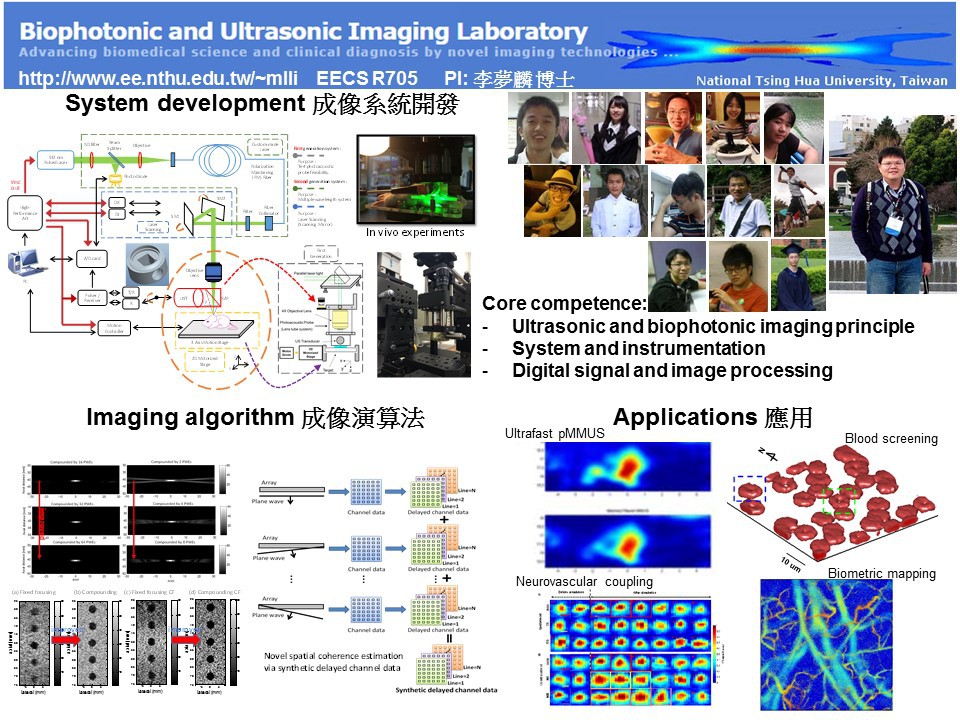
Gas Experiment and Material Coating Laboratory
Prof. Kea Tiong Tang
This laboratory supports the EE faculty to research on gas experiment and sensing material coating. The lab provides equipment of material coating, sensor measurement, and gas experiment.
Laboratory for Reliable Computing (LaRC) - NBME ( Neuromorphic and Biomedical Engineering Lab)
Prof. Kea Tiong Tang
Our lab focuses in the integration of electronics and life science. Based on analog/mixed-signal IC design, we conduct research in two domains:
(1) Biomimetic system IC: For example, electronic nose can sense the gas molecules in the air for long-term monitoring and detection. This system can be applied to environmental monitoring, medical diagnosis, and food freshness to improve the quality of life.
(2) Biomedical system IC: We design implantable ICs for retinal prosthesis and deep brain stimulation. These ICs provide a potential solution for unmet medical needs.
Laboratory for Reliable Computing (LaRC) - Signal Sensing and Application Lab (SiSAL)
Prof. Chih-Cheng Hsieh
The SiSAL (Signal Sensing and Application Laboratory) group was formed in September 2007 in the department of Electrical Engineering at National Tsing Hua University, and is advised by the Professor Chih-Cheng Hsieh.
The primary goal of SiSAL is the research and development of innovative circuit and system level solutions including CMOS imaging sensor IC, low-voltage low-power analog-to-digital converter (ADC), smart image sensing IC with array-level preprocessing, analog and mixed-mode IC, and biomedical sensing applications. The research objective of SiSAL is concluded by the cooperation with industry and other research center ensured by regular interaction. As part of the Laboratory of Reliable Computing (LaRC), an academic research/industry and university consortium, SiSAL strives to create breakthroughs beneficial to the focused research areas.
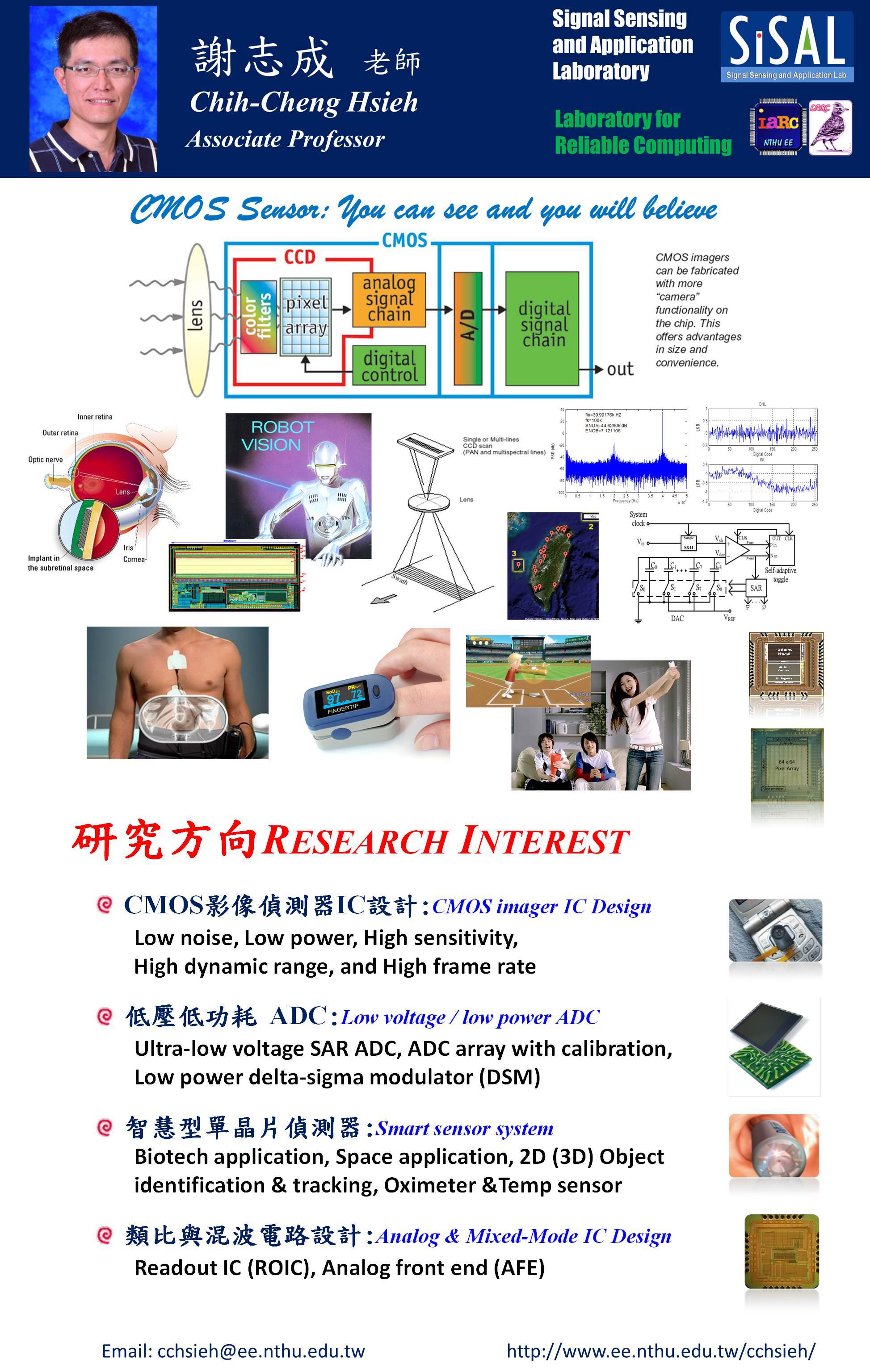
Prof. Yi-Wen Liu
Students at all levels (PhD, MS, undergraduates) with interdisciplinary background (Math, Physics, Engineering, Biology) are welcome to join. Ongoing research topics include:
1. "Acoustic Reality Mining" via networked microphones
2. Computer modeling of cochlear mechanics and neural dynamics in the auditory brainstem
3. Biology-inspired machine listening
4. Otoacoustic emissions: Theory and measurements
Laboratory for Reliable Computing (LaRC) - Energy-Efficient Systems Research Group (EESRG)
Prof. Ping-Hsuan Hsieh
Our research is focused on energy-efficient circuits and systems designs, including high-speed electrical data communications, clocking and synchronization systems, and energy harvesting systems for wireless sensor networks and machine-to-machine applications.
Vision Circuits and Systems Lab
Prof. Chao-Tsung Huang
Our research focuses on digital circuits and systems for computer vision applications, especially for light-field processing and computational photography. The design space is from algorithm exploration to VLSI architecture design, chip implementation, and demo system. Our goal is to investigate how far we can push the boundaries of computer vision applications with the continually increasing digital processing power.
Behavioral Informatics & Interaction Computation Lab (BIIC)
Prof. Chi-Chun Lee
BIIC lab conducts fundamental and applied research in human-centered behavioral signal processing (BSP) – an interdisciplinary research direction across behavioral science and engineering. BIIC lab objective is to develop novel computational algorithms, i.e., behavioral informatics, to model human behaviors during interactions in a domain-aware & scientifically-relevant manner. These computational methods that model human behavior signals that are manifested in both overt and covert cues, processed and used by humans explicitly or implicitly, and facilitate human analysis and decision making.
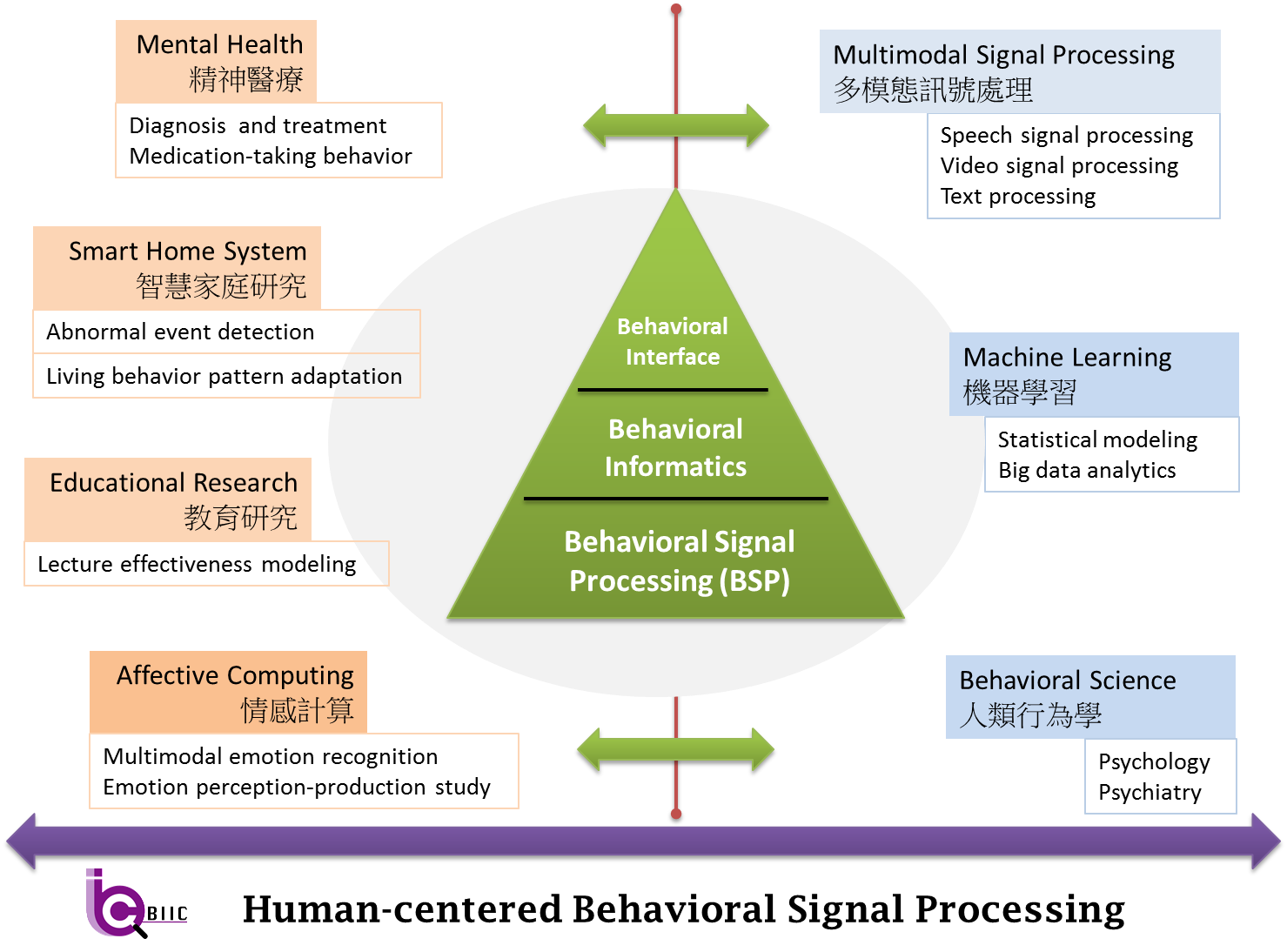
Prof. Min Sun
Vision science and its technologies have great impact in computer vision, robot vision, mobile vision, etc. I aim to build game changing applications that improve our daily life, where vision science is the key enabler.
As for now, I focus on taking advantages of A) the huge amount of 2D/3D/4D visual data (e.g., images, depths, videos, etc.) and B) the ubiquitous sensory information that captures human behaviors (e.g., gaze, GPS location, motion, etc.) to understand the world we live in. I envision that the ability to understand how humans interact with/in the world opens the doors for vision science to improve our family life, traveling/transiting experience, and working condition.
System and Storage Design Laboratory (SSD Lab)
Prof. Ren-Shuo Liu
Students having interests in computer architecture and computer systems are welcome to join in!
Studying computer architecture and systems involves hardware-software co-design and multidiscipline techniques. These types of π -style talents and backgrounds are increasingly valuable to the industry nowadays.
Our ongoing research topics include:
1. Architecting computer solid state storage, e.g., SSDs
2. Architecting computer main memory
3. Emerging techniques such as many-core processing and in-memory processing
Prof. Pen-Jui Peng
https://penjuipn.wixsite.com/my-site

